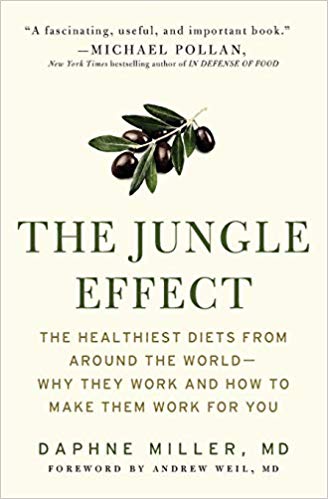I pulled into the parking lot of Las Tres Hermanas, a Mexican grocery store in my town, with several items on my list and absolutely no command of the Spanish language. I pushed through the broken automatic door and slowly made my way under colorful piñatas hanging from the ceiling and past the small food counter selling five-star-rated steak tacos, to the fresh vegetables lining the far wall.
The small produce section was cluttered with handwritten signs for various fruits and vegetables, written only in Spanish. I knew tomatillos by looking at them, plus their name is the same in English and Spanish, so I picked up five. I glanced down at my list where I’d written epazote, cilantro, and jicama, which I assumed would all be fresh, but since I’d copied them from recipes in Daphne Miller’s book, The Jungle Effect: The Healthiest Diets from around the World—Why They Work and How to Make Them Work for You, I didn’t know if those words were also the same in Spanish.
I buy cilantro almost weekly in the local chain grocery store, so I recognized it immediately despite a misplaced sign. There were no signs indicating epazote, nor did I find other fresh bunches of herbs that would likely be it. But I did see jicama scrawled on a little sign next to what I thought was a coconut. Though I didn’t know for sure, I expected jicama to look like a white carrot—later I learned that it looks more like a potato. But I looked around at all the other signs near the coconut for several seconds, hoping to confirm what I was seeing. Eventually, in the same slanted script as the others, I read, “Coco.” No jicama? I wondered.
Though Las Tres Hermanas is less than a mile from my home, I’d only been there one other time to buy the Mexican crema one son loves on tacos. On this trip, I’d been there 10 minutes already and hadn’t made it past the first aisle. But I still had several items on my list, so I continued on.
In the next section of dried herbs and seeds, I found dried epazote, along with pepitas and serrano chilis. I spent another 10 minutes in the canned food aisle, trying to figure out if hominy is pozole or is just like pozole. (I’m still not sure.) And after scanning the labels of several bags of milled grains, I finally found masa harina, which I needed for homemade tortillas. My last stop was the dairy case, where I easily found a package of blanco queso, or white crumbling cheese, and then I headed to the checkout lane, where the cashiers and I managed to finalize my transaction with broken English, hand gestures, and a lot of pointing and reading.
I’m not from Mexico, and its grains, herbs, and cheeses aren’t part of my own indigenous diet. But the diet my own people formed, using using local foods and their traditional knowledge, is hard to nail down exactly. My family surname originates in England, though most recently my Dad’s family migrated to Indiana from Kentucky. I know less about my mom’s family, though they’re also likely northern European, with at least one Cherokee intermarriage four generations back. In other words, I don’t live in an ancestral land, and neither have my family elders for more than two centuries.
That’s not to say that my ancestors didn’t adopt the indigenous diet of their “New World” home. Earlier in the book club, I wrote about the food culture of my dad’s generation, and of his parents’ generation, that contained all the hallmarks of an indigenous diet.
But even as early as the turn of the 19th century, food processing was moving away from the home and toward industrialization, first with canning and bottling, and eventually with freezing and sealing in paper, plastic, and cardboard. Beyond modern processing techniques, so much has changed with genetically modified seeds, crossbred animal species, commercial and farmed fishing, food safety guidelines, and cooking techniques. I doubt it’s an exaggeration to say that most of us would find it impossible to eat a truly indigenous diet like our ancestors did.
Returning to a purist version of our own individual indigenous diets is not the point of The Jungle Effect, though. In fact, Miller says that “taste and connection to a place or tradition” are probably more important in deciding which indigenous foods to eat than genes or family history. Miller herself admits to rotating through recipes from all five of her cold spot diets, and based on my family’s tastes and preferences, I plan to do the same.
“There is no set formula for helping you identify the indigenous diets that best meet your needs,” Miller writes. “It seems that any diet will do so long as it is not a modern one.”
Still, it is nearly impossible to leave behind the modern world completely. For instance, in order for me to buy local ingredients, I rely on an Indiana company called Market Wagon, which uses a snazzy online app to connect food shoppers like me to local farmers. I order what I want from an online “catalog,” farmers and artisans from throughout the state bring the food to a centralized packing location, and then my selections are delivered in cooler bags to a nearby market where I pick them up. It’s basically a modern, online version of a farmers market. In the summer, I often shop at actual farmers markets, but the closest ones are 45 minutes away. In the winter, I’d have no hope of eating locally at all without Market Wagon.
Even with Market Wagon, eating locally during Indiana winters is limited to pasture-raised meats, dairy, and eggs; fruits and vegetables that are harvested in late fall and can be sold throughout the winter, like apples, hard squashes, and root vegetables; and certain greens, like kale and spinach, that a few organic farmers grow in heated hoop houses throughout the cold months. For other vegetables and most fruits, along with grains, oils, and, if I’m honest, the chips, granola bars, and other snacks we still consume too much of, I’m limited to one of a few grocery stores in town.
Also, living in a small, Midwest city means some of the ingredients for recipes from other parts of the world simply aren’t available fresh or at all. I did manage to find cactus pads, which I have not tried yet, and fresh epazote during my trip to Las Tres Hermanas, after asking the clerk. But when I went back to buy a tortilla press, they didn’t have one. I tried another store, Azteca Grocery Store, and they didn’t have one either. So I opted to buy one on Amazon, a thoroughly modern compromise to my indigenous diet dilemma.
In Chapter 10 of The Jungle Effect, Miller documents her own attempts at shopping for and eating foods that align with her cold spot indigenous diets. She begins the chapter with a question: “Is it realistic to think that people across this country could put this eating plan into action?” It’s a question I’ve been asking myself throughout reading and writing about this book, and it’s a question some of you have been asking as we’ve discussed these principles.
Like my own cobbled together approach, the answer isn’t simple. In our global, modern world, we can’t entirely remove ourselves from the modern processed food industry. But we can take steps to move closer to a diet that keeps us healthier and offers a healthier relationship to food by prioritizing the principles of indigenous diets we discussed in week one. Miller offers a few next steps to make that happen:
- Shop at farmers’ markets if possible
- Start your own backyard or community garden
- Buy whole ingredients rather than premade foods
- Buy high quality meat when possible
- Buy local, in-season foods when possible
- Stock up on in-season foods and learn to can, dry, or freeze them for winter
- Avoid foods that have ingredients you don’t understand or can’t pronounce
- When in doubt, select foods with simpler packaging
We can eat differently, even if it means eating differently than everyone around us. And hopefully, as we find our way to indigenous foods that make us healthier and happier, the trend will catch on. As Miller says, “If we can export these packaged modern foods with such efficiency, we certainly can export a renewed commitment to eating authentic, indigenous foods.”
For Your Consideration
Over the past three weeks, we’ve considered our family’s food story and our own inclinations toward healthy eating. This week, what’s one thing about your current diet that you’re considering changing as a result of this book club, if any?
Want to catch up? Explore the previous posts in this discussion:
Week 1 (January 22): Chapters 1-4: The Basics of Indigenous Diets and How They Work
Week 2 (January 29): Chapters 5-9: Specific Indigenous Diets and What They Have in Common
Week 3 (February 5): Chapter 10 through Appendice G: How to Find an Indigenous Diet that Works for You
Make Plans for Other Upcoming Winter Book Clubs at Tweetspeak
In 2020 we embark on our Year of Wisdom journey at Tweetspeak, and just as we approach everything we do here in a multi-faceted way, looking at any question from myriad angles—from the serious to the mischievous, from the forthright to the nuanced, from the erudite to the whimsical—our broad range of book clubs will help guide us in that journey from a variety of vantage points.


____
Photo by Gopal Vijayaraghavan, Creative Commons license via Flickr. Post by Charity Singleton Craig.
- Grammar for a Full Life Book Club: On Becoming Less Possessive - June 16, 2021
- Grammar for a Full Life Book Club: Chilling Out on the Grammar Rules - June 9, 2021
- Grammar for a Full Life Book Club: A Passive Voice - June 2, 2021


Will Willingham says
Charity, looking for an unfamiliar vegetable in a produce section labeled in a language foreign to you is a metaphor for … something. (And also a delightfully amusing image.)
I so appreciate this list of suggestions. While I can’t grow a garden now (neither backyard nor balcony patio), making the trip to the farmer’s market can fill part of that void. And learning what in-season and local items I can round up is a great idea.
Thanks for leading us through this terrific and helpful volume. Your experience with navigating this route has been super helpful and interesting!
Charity Singleton Craig says
Will — It was super helpful and interesting to me, too. What a great book! This is our second one by Daphne Miller, and she is a great writer about these topics. I’m glad the list inspired you to do what you can for now. I really think so many great food habits can come from that kind of mentality, rather than having to do a complete overhaul of our diets.
Thanks for all your help on the logistics of this series!